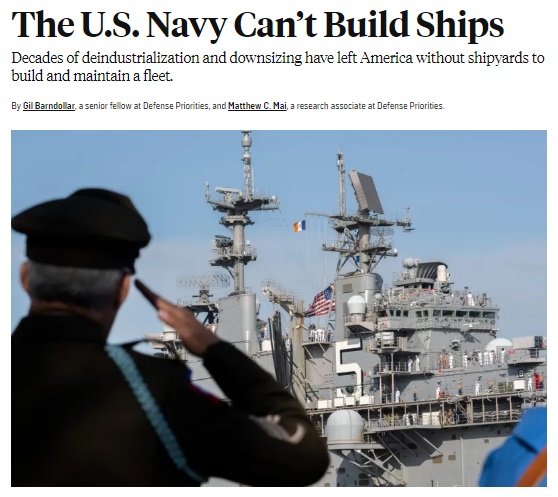 Photo: Getty Images
Photo: Getty Images
Decades of deindustrialization and downsizing have left America without shipyards to build and maintain a fleet, notes ‘The Foreign Policy’.
After decades of strategic drift and costly acquisition failures, the U.S. Navy is sailing straight into a storm it can’t avoid. Despite the Defense Department’s lip service about China being the “pacing challenge,” decades of deindustrialization and policymakers’ failure to prioritize among services and threats have left the Navy ill-equipped to endure a sustained high-intensity conflict in the Pacific. The United States is unable to keep pace with Chinese shipbuilding and will fall even further behind in the coming years. Where does that leave the U.S. Navy and the most critical U.S. foreign-policy imperative: deterring a war in the Pacific?
As evidenced by the Biden administration’s latest budget request, fiscal constraints are forcing the Navy to cut procurement requests, delay modernization programs, and retire ships early. The Navy’s budget for the 2025 fiscal year calls for decommissioning 19 ships — including three nuclear-powered attack submarines and four guided-missile cruisers — while procuring only six new vessels. The full scope of what military analysts have long warned would be the “Terrible ’20s” is now evident: The expensive upgrading of the U.S. nuclear triad, simultaneous modernization efforts across the services, and the constraint of rising government debt are compelling the Pentagon to make tough choices about what it can and cannot pay for.
Workforce shortages and supply chain issues are also limiting shipbuilding capacity. The defense industrial base is still struggling to recover from post-Cold War budget cuts that dramatically shrank U.S. defense manufacturing. The Navy needs more shipyard capacity, but finding enough qualified workers for the yards remains the biggest barrier to expanding production. The shipbuilding industry is struggling to attract talent, losing out to fast food restaurants that offer better pay and benefits for entry-level employees. At bottom, it is a lack of welders, not widgets, that must be overcome if the U.S. Navy is to grow its fleet.
Instead, the shipbuilding outlook is progressively worsening. An internal review ordered by Navy Secretary Carlos Del Toro in January found that major programs, including submarines and aircraft carriers, face lengthy delays. Even the Constellation-class frigates, touted as a quick adaptation of a proven European design, are delayed by three years.
As defense analyst David Alman outlined in a prize-winning essay for the U.S. Naval Institute’s Proceedings, the United States simply can’t win a warship race with China.
The U.S. Office of Naval Intelligence estimates that China now has 232 times the shipbuilding capacity of the United States. China built almost half the world’s new ships in 2022, whereas U.S. shipyards produced just 0.13 percent.
Realizing that U.S. shipyards are stretched thin, policymakers have begun looking abroad. Del Toro encouraged South Korean companies to invest in U.S. naval shipping during a visit this year. Japan will likely begin performing repair and maintenance work on U.S. warships soon; India agreed to do so last year. These initiatives will alleviate the increasing maintenance backlog at U.S. facilities, but it would take a large share of the combined Japanese and South Korean shipyard capacity to fundamentally alter the growing disparity between the U.S. and Chinese fleet size in the Western Pacific.
After 20 years of largely uncontested deployments to the Middle East, the U.S. Navy now has an opponent who shoots back: Yemen’s Houthis. But increased experience in missile and drone defense is outweighed by a deleterious drain on precision munitions. In the conflict with the Houthis, the Navy burned through more Tomahawk land attack missiles in one day than it purchased in all of 2023.
The costs of maintaining global presence are magnified by the state of Navy recruiting and retention. The service’s recruiting woes are undeniable. The Navy missed all of its recruiting goals in 2023, some by as much as 35 percent. The service projects a shortfall of 6,700 recruits this year, according to its chief personnel officer.
The United States can’t match the size of China’s fleet in the near or medium term. Deindustrialization, poor procurement choices, and a myopic fixation on the U.S. presence in the Middle East have seen to that, concludes ‘The Foreign Policy’.
read more in our Telegram-channel https://t.me/The_International_Affairs

 11:11 30.05.2024 •
11:11 30.05.2024 •






















